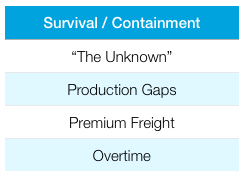
Your first focus has to be on those things that prevent stability. These symptoms include, but are not limited to anything that:
- causes production interruptions
- requires expensive containment
- causes your team to incur expensive premium freight charges, or
- forces people to work unplanned overtime for which you are unable to seek recovery because it is due to your lack of efficiency or readiness.
In short, if it will affect stakeholders in the form of cost, timing or quality, it has to be eliminated before you can ever achieve stability.
Survival/containment inherently includes a phase of discovery. The objective is to “overturn all of the stones” to confront the reality of what’s hiding under them. In the simplest terms, the objective is to observe and classify as either “important” or “urgent”. Urgent items will be addressed in the survival/containment phase of the turnaround and have some of the characteristics listed, above. Important items will be captured on issues lists after being considered for scale (measured) and categorized to determine who, or which department, should be working on them in the “get organized” phase.
By separating important from urgent, the team will not only identify the items that will be resolved during the survival/containment phase, but they set up the finite list of assignments and issues to be addressed in the future. Also, when there is down-time during survival/containment, team members can reach ahead into the future state of the business by using the available bandwidth to begin the organized attack on the finite, categorized issues lists and start getting organized.
A parallel activity, that will be discussed at length in later in this publication, to the direct phases of a turnaround is to define the inputs, outputs and “business of my business” (BOMB) for each function in the organization. The confluence of the input/output analysis and the getting organized phase will introduce a sense of predictability and calm to each person, function and department in the company.
Once the urgent items have been identified, they have to be worked on with extreme focus with a sense of urgency on arriving at a solution. These are not the types of items where the immediate appropriate action is to form a committee, review our processes or call a meeting next week. These require immediate intervention. Anything less is just kicking the can down the road and is, likely, the behavior that allowed them to go from important to urgent in the first place.
An effective means of applying appropriate attention is for Vice Presidents to divide the urgent items evenly between their directors (or directors to divide them evenly between their managers). These assignments must be made whether the directors have specific responsibility for the particular issue or not. Each person assigned an issue to resolve has to immerse themselves in the topic and have a clear sense of ownership to provide a solution. They must know, or have the assistance of somebody that knows, a credible problem solving means (i.e. Shanin Red X, Kepner-Tregoe, etc.) to ensure a direct approach to a solution. This will prevent the expenses and time required for a trial-and-error approach.
The cadence of follow up for survival/containment items has to be indicative of the implied urgency of the issues. It is not unreasonable for a Monday-Wednesday-Friday, or even daily, 30 minute review where each champion reports out for a couple of minutes. Urgent issues call for sudden action. The daily follow up should include reports about walking over and seeing someone, flying to the source of the issue (going to gemba) or at least calling people on their phones to get the logical progress that is required to secure the solution. Sending emails and setting up meetings next week are only acceptable as means to follow up. If they are the primary tools of engagement, then the person assigned to that issue does not understand the urgency with which the topic should be approached.
So, survival/containment is about identifying those items that will have a substantive affect on the enterprise if not resolved. Appropriate urgency should be engaged in resolving these critical items and frequent follow up is required to assess progress toward a solution. “Getting organized”, the step that follows survival/containment, is addressed in the next section.

 RSS Feed
RSS Feed
